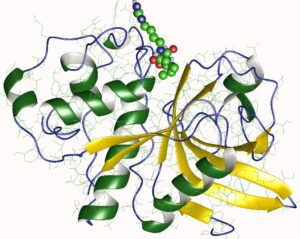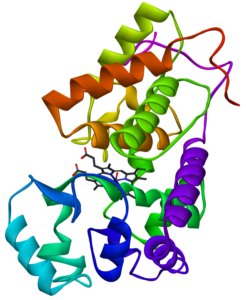This article account the detailed facts about various plant enzyme examples.
Enzymes are also referred to as biological catalysts that accelerate cellular biochemical reactions by lowering the threshold energy. Plants also produce these proteinaceous biomolecules for their growth and development.
- Actidin
- Bromelain
- Papain
- Ficin
- Legumain-like proteases
- Horseradish peroxidase
- Peanut peroxidase
- Soybean peroxidase
- Invertase
- α-Amylase
- β- Amylase
- β- Glucanase
- Lipoxygenase
- Phytase
- Lipase
- Hydroxynitrile lyase
- Nitrate reductase
- Urease
Actinidain
This is a type of cysteine protease commonly found in Kiwi fruit, pineapple, mango, banana and papaya. This is frequently used as a meat tenderizer and milk coagulant. The denaturation temperature is 60 °C.

Bromelain
It is obtained from the stems of the pineapple. This is a cocktail of various enzymes such as phosphatase, peroxidases, glycoproteins, cellulase and various other proteases. There are two types of bromelains. One is stem bromelain while the other one is fruit bromelain which shows greater proteolytic activity. It acts as a meat tenderizer with 50°C optimal temperature.
Papain
Papain is also a cysteine protease derived from papaya and is widely used in the food, textile, detergent, and leather industries. This enzyme performs several other activities such as endopeptidases, aminopeptidase, trans-esterase, and amidase. The optimal temperature ranges from 10-90°C with 5-7 pH.

Ficin or ficain
This cysteine endopeptidase enzyme is present in the latex of Ficus (Ficus glabrata, F. elastica, F. carica). This enzyme exhibits anthelminthic activity. The optimal temperature is 45-55°C and pH is 5-8.

Legumain-like proteases
These are a group of proteases that reside in the vacuoles of plant cells and perform multifaced functions during plant growth. These are functionally similar to animal caspases. They perform specific proteolytic activity after asparagine and aspartic acid residues. It was first isolated from the cotyledons of Vicia sativa.
Horseradish peroxidase
This is a heme-containing peroxidase enzyme obtained from the roots of horseradish (Amoracia rusticana) and is extensively used in biotechnology such as in the ELISA test, and immunoblotting. This enzyme is often conjugated with a fluorescent agent and can be easily detected when incubated with the proper substrate.

Peanut peroxidase
This peroxidase is obtained from peanuts (Arachis hypogaea).
Soybean peroxidase
This peroxidase is obtained from the soybean (Glycine max) seed coat. This enzyme belongs to the family of class III plant peroxidases and exhibits excellent stability and catalytic properties. This enzyme is also useful in biotechnology as biosensor.
Invertase
This enzyme hydrolyzes the cleavage of disaccharides into hexose monosaccharides. In plants, there are three types of invertase which are present in apoplast, cytoplasm, and vacuole. These enzymes perform a pivotal role in various aspects of plant growth and development, carbohydrate partitioning, and other biotic and abiotic interactions.
α-Amylase
This enzyme hydrolyses carbohydrates. In plants, it breaks down starch and usually plays an important role in seed germination. This enzyme is present in the aleurone layer of cereal seeds. There it hydrolyses the starchy endosperm and provides a constant source of soluble sugars necessary for root and shoot growth.
β- Amylase
This enzyme is mostly present in seeds and sweet potatoes which hydrolyses the glucose-glucose bonds and produces maltose. This enzyme is responsible for the sweetness of ripened fruit. The optimum pH is 4-5.5. It is present in the vacuole, cytoplasm, and the stroma of mesophyll cells.
β- Glucanase
β- Glucanase play a wide range of activities in plants. They play important role in cell division, seed maturation, translocating of materials through plasmodesmata, and specifically in plant defense. It is present in various crops such as barley, soybean, and wheat and is often expressed with other anti-fungal proteins.
Lipoxygenase
These are found in many plants. However, specifically in soybean, it shows enhanced activity. Soybean seeds contain three types of lipoxygenases. This enzyme catalyzes polyunsaturated fatty acids. It plays important role in the regulation of growth, antimicrobial activity and signaling molecules.
Phytase
This enzyme has been isolated from grains of wheat, rice, maize, and oilseeds of rapeseed, soybean, and rye. This is a type of phosphatase enzyme that hydrolyses phytic acid and releases inorganic phosphorus.
| Plant Sources of phytase | pH |
| Buttercup squash, canola seed, soybean seeds, tomato roots, rice, faba beans, hazel seed, sunflower peanut, rapeseed, barley, maize, wheat bran, oat, rye | 4-6 |
| Legume seed, mung beans, wheat bran | 7-8 |
Lipase
This enzyme is obtained from pine nuts, lentils, coconut, oats, castor beans, and mungbean. It exchanges the position of fatty acid chains present in the glyceride. It also causes esterification and also transesterification along with hydrolysis of fatty acids. This enzyme is used in the food, leather, textile, and paper industries.
Hydroxynitrile lyase
This enzyme catalyzes the enzymatic synthesis of a wide range of cyanohydrins. Cyanohydrins are of greater importance in pharmaceuticals and agrochemical industries. These are obtained from almonds, flaxseed, apple, apricot, peach, and rubber tree.
Nitrate reductase
This is the key enzyme necessary for nitrogen assimilation. It also regulates plant growth and promotes resistance against biotic and abiotic stresses. It catalyzes the rate-limiting step in the reduction of nitrate into nitrite. This enzyme is present in most crops.
What is plant enzyme?
Enzymes are highly specific biomolecules that catalyze various reactions.
Plant enzymes mainly focus on their own growth and development. Plant synthesizes an array of enzymes that performs multifarious functions. They can be classified broadly into peroxidase, protease, amylase, reductase, and invertase. These enzymes provide resistance against various biotic and abiotic stress by maintaining cellular homeostasis along with other regulatory functions.
Plant enzyme structure
These are proteinaceous biomolecules.
The precursor of these enzymes contains amino-acid residues arranged in polypeptide chains. Often these polypeptide chain contains disulfide bridges. Along with these, it contains a catalytic center with distinct structural domain.
Conclusion-
Plant enzymes are active proteinaceous biomolecules that perform a wide range of functions. The major groups of enzymes involves peroxidases, invertase, proteases, amylases. These enzymes perform various cellular function, act as defense mechanism against biotic and abiotic stress as well as these have industrial and biotechnological importance.
Also Read:
- Staphylococcus bacteria examples
- What is plasmid dna in bacteria
- Does mitochondria have double membrane
- Seed plant examples
- Colon anatomy
- Nucleus and endoplasmic reticulum
- Do bacterial cells have cytoplasm
- Hypertonic solution example
- Single cell plant examples
- Drupe fruit example

I am a doctoral student of CSIR- CIMAP, Lucknow. I am devoted to the field of plant metabolomics and environmental science. I have completed my post-graduation from the University of Calcutta with expertise in Molecular Plant Biology and Nanotechnology. I am an ardent reader and incessantly developing concepts in every niche of biological sciences. I have published research articles in peer-reviewed journals of Elsevier and Springer. Apart from academic interests, I am also passionate about creative things such as photography and learning new languages.
Let’s connect over Linkedin